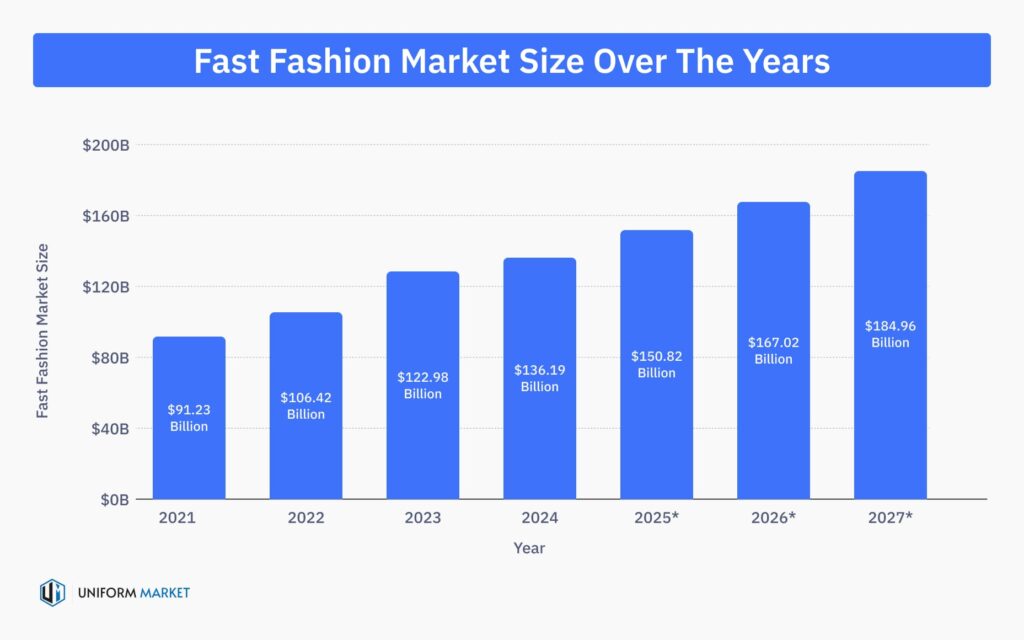Machinery of Fast Fashion and its Impact on Pollution
The fashion industry has been increasing because many people are interested in new fashion, and it has become a form of expressing themselves. Fast fashion is partly because the fashion industry now releases new clothing brands such as H&M, Gap, Nike, Chanel, and Louis Vuitton every week when historically, this happened four times a year. Today, business has been increasing because many people want to increase in wealth.
The fast industry can be seen as a tool to increase wealth since many are interested in fashion. However, machinery is essential to produce all these clothing in different brands. Machinery ranges from small sizes, such as sewing machines, to large, heavy-duty machines that create clothes rapidly. Yarn gassing machines are used to eliminate the excuses fuzz and deepen the color of the clothes. As well as bleaching machines, dying machines, and woolen mill machines (Tiseo, 2022). Bright, colorful colors capture the eyes of many customers. However, this machinery hurts the environment. For example, the fashion industry, one of the world’s largest water users, consumes anywhere from 20 trillion to 200 trillion liters annually (Tiseo, 2022).
Rise of Machinery Use
The fast industry can be seen as a tool to increase wealth since many are interested in fashion. However, machinery is essential to produce all these clothing in different brands. Machinery ranges from small sizes, such as sewing machines, to large, heavy-duty machines that create clothes rapidly. Yarn gassing machines are used to eliminate the excuses fuzz and deepen the color of the clothes. As well as bleaching machines, dying machines, and woolen mill machines (Tiseo, 2022). Bright, colorful colors capture the eyes of many customers. However, this machinery hurts the environment. For example, the fashion industry, one of the world’s largest water users, consumes anywhere from 20 trillion to 200 trillion liters annually (Maiti, 2025). This machinery uses lots of water to create the clothes and allow the machine to start its process. After the machinery finishes creating many clothes, all the water left from the dying process is often dumped into ditches, streams, or rivers (Maiti, 2025). This hurts the water, but the water is also essential to the earth. Humans benefit from water, and animals can also impact how we use water. Often, it can be seen that human action also has a negative outcome. Fast fashion is created with textiles that fit into two broad categories: natural and synthetic. Most brands use polyester, nylon, and acrylic fibers to create clothing. However, around 35% of microplastics enter the ocean (Maiti, 2025).

Cardona, N. (2025, February 3). Fast Fashion Statistics 2025 | UniformMarket. UniformMarket. https://www.uniformmarket.com/statistics/fast-fashion-statistics
Proposal
As these industries grow larger, more clothing is created, causing water pollution to increase more and more. Many have observed that the water population has increased such as Current World Environment stated, “One proposed regulation is the 2022 Fashion Act, which would require fashion brands operating in New York with revenue over $100 million to take measures such as tracking the supply chains of their clothing products and disclosing their water and chemical use. If companies fail to comply with requirements, they will be fined 2% of their global revenue”. They have suggested that a way to reduce the pollution in the water is to take these small steps to help reduce population growth. However, it won’t stop the population within the water. It’s tough to stop all our human actions once it has already affected the environment. As these large machinery are used to create large products, they cause many different types of pollution, not just water pollution. For this large machinery to be used, it’s essential to use energy. Large amounts of petroleum, particular matter, as well acid like hydrogen chloride (Maiti, 2025). This leads to the large use of gasses that impact the earth’s temperature, which we can see even leads to climate change. Over the years, fashion has been increasing and will continue to increase. We would never have thought that fashion could impact the environment. However, fashion is used to express our emotions and thoughts using different styles of clothing and fabric. The making of these clothing with the use of other large machinery is the thing that impacts pollution.
Sources:
- Maiti, R. (2025, January 20). The Environmental Impact of Fast Fashion, Explained. Earth.org. https://earth.org/fast-fashions-detrimental-effect-on-the-environment/
- Tiseo, I. (2022, October 5). Fast fashion’s waste problem. Nature. https://www-nature-com.ccny-proxy1.libr.ccny.cuny.edu/articles/d41586-022-02914-2

